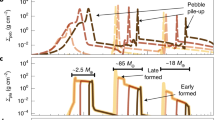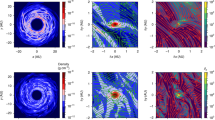Abstract
Nearly all young stars are initially surrounded by ‘protoplanetary’ disks of gas and dust, and in the case of single stars at least 30% of these disks go on to form planets1. The process of protoplanetary disk formation can result in initial misalignments, where the disk orbital plane is different from the stellar equator in single-star systems, or different from the binary orbital plane in systems with two stars2. A quirk of the dynamics means that initially misaligned ‘circumbinary’ disks—those that surround two stars—are predicted to evolve to one of two possible stable configurations: one where the disk and binary orbital planes are coplanar and one where they are perpendicular (a ‘polar’ configuration)3,4,5. Previous work has found coplanar circumbinary disks6, but no polar examples were known until now. Here, we report the first discovery of a protoplanetary circumbinary disk in the polar configuration, supporting the predictions that such disks should exist. The disk shows some characteristics that are similar to disks around single stars, and that are attributed to dust growth. Thus, the first stages of planet formation appear able to proceed in polar circumbinary disks.
This is a preview of subscription content, access via your institution
Access options
Access Nature and 54 other Nature Portfolio journals
Get Nature+, our best-value online-access subscription
$29.99 / 30 days
cancel any time
Subscribe to this journal
Receive 12 digital issues and online access to articles
$119.00 per year
only $9.92 per issue
Buy this article
- Purchase on Springer Link
- Instant access to full article PDF
Prices may be subject to local taxes which are calculated during checkout



Similar content being viewed by others
Data availability
The ALMA data used in this study are available in the ALMA Science Archive (project code 2017.1.00350.S). Post-processing, modelling and other code used in this study are available on GitHub at https://github.com/drgmk/hd98800_alma_c5. Post-processed data that support the plots within this paper and other findings of this study are available from the corresponding author upon reasonable request.
Change history
07 February 2019
In the version of this Letter originally published, the Author Contributions section was mistakenly omitted, and should have read: “G.M.K. conceived the project, analysed the data, carried out the modelling and wrote the manuscript. L.M. contributed gas calculations and provided advice on self-calibration. B.M.Y. set up and ran the n-body simulations. D.P. provided advice on running the smoothed particle hydrodynamics simulations. All co-authors provided input on the manuscript.” In addition, in the fourth paragraph, due to a typographical error the value of the ascending node was incorrect as 289 ± 1° and should have been 337.6 ± 2.4°. These errors have now been corrected.
References
Zhu, W., Petrovich, C., Wu, Y., Dong, S. & Xie, J. About 30% of Sun-like stars have Kepler-like planetary systems: a study of their intrinsic architecture. Astrophys. J. 860, 101 (2018).
Bate, M. R. On the diversity and statistical properties of protostellar discs. Mon. Not. R. Astron. Soc. 475, 5618–5658 (2018).
Aly, H., Dehnen, W., Nixon, C. & King, A. Misaligned gas discs around eccentric black hole binaries and implications for the final-parsec problem. Mon. Not. R. Astron. Soc. 449, 65–76 (2015).
Martin, R. G. & Lubow, S. H. Polar alignment of a protoplanetary disk around an eccentric binary. Astrophys. J. Lett. 835, L28 (2017).
Zanazzi, J. J. & Lai, D. Inclination evolution of protoplanetary discs around eccentric binaries. Mon. Not. R. Astron. Soc. 473, 603–615 (2018).
Rodriguez, D. R., Kastner, J. H., Wilner, D. & Qi, C. Imaging the molecular disk orbiting the twin young suns of V4046 Sgr. Astrophys. J. 720, 1684–1690 (2010).
Brinch, C., Jørgensen, J. K., Hogerheijde, M. R., Nelson, R. P. & Gressel, O. Misaligned disks in the binary protostar IRS 43. Astrophys. J. Lett. 830, L16 (2016).
Farago, F. & Laskar, J. High-inclination orbits in the secular quadrupolar three-body problem. Mon. Not. R. Astron. Soc. 401, 1189–1198 (2010).
Foucart, F. & Lai, D. Assembly of protoplanetary disks and inclinations of circumbinary planets. Astrophys. J. 764, 106 (2013).
Lubow, S. H. & Martin, R. G. Linear analysis of the evolution of nearly polar low-mass circumbinary discs.Mon. Not. R. Astron. Soc. 473, 3733–3746 (2018).
Martin, R. G. & Lubow, S. H. Polar alignment of a protoplanetary disc around an eccentric binary—II. Effect of binary and disc parameters. Mon. Not. R. Astron. Soc. 479, 1297–1308 (2018).
Haisch, K. E. Jr., Lada, E. A. & Lada, C. J. Disk frequencies and lifetimes in young clusters. Astrophys. J. Lett. 553, L153–L156 (2001).
Kennedy, G. M. et al. 99 Herculis: host to a circumbinary polar-ring debris disc. Mon. Not. R. Astron. Soc 421, 2264–2276 (2012).
Van Leeuwen, F. Validation of the new Hipparcos reduction. Astron. Astrophys. 474, 653–664 (2007).
Kastner, J. H., Zuckerman, B., Weintraub, D. A. & Forveille, T. X-ray and molecular emission from the nearest region of recent star formation. Science 277, 67–71 (1997).
Barrado Y Navascués, D. On the age of the TW Hydrae association and 2M1207334-393254. Astron. Astrophys. 459, 511–518 (2006).
Boden, A. F. et al. Dynamical masses for low-mass pre-main-sequence stars: a preliminary physical orbit for HD 98800 B. Astrophys. J. 635, 442–451 (2005).
Walker, H. J. & Wolstencroft, R. D. Cool circumstellar matter around nearby main-sequence stars. Publ. Astron. Soc. Pac. 100, 1509–1521 (1988).
Akeson, R. L. et al. The circumbinary disk of HD 98800B: evidence for disk warping. Astrophys. J. 670, 1240–1246 (2007).
Andrews, S. M. et al. Truncated disks in TW Hya association multiple star systems. Astrophys. J. 710, 462–469 (2010).
Ribas, Á., Macías, E., Espaillat, C. C. & Duchêne, G. Long-lived protoplanetary disks in multiple systems: the VLA view of HD 98800. Astrophys. J. 865, 77 (2018)..
Furlan, E. et al. HD 98800: a 10 Myr old transition disk. Astrophys. J. 664, 1176–1184 (2007).
Wyatt, M. C. et al. Transience of hot dust around Sun-like stars. Astrophys. J. 658, 569–583 (2007).
Riviere-Marichalar, P. et al. Gas and dust in the TW Hydrae association as seen by the Herschel Space Observatory. Astron. Astrophys. 555, A67 (2013).
Yang, H. et al. A far-ultraviolet atlas of low-resolution Hubble Space Telescope spectra of T Tauri stars. Astrophys. J. 744, 121 (2012).
Andrews, S. M. et al. The TW Hya disk at 870 μm: comparison of CO and dust radial structures. Astrophys. J. 744, 162 (2012).
Facchini, S., Birnstiel, T., Bruderer, S. & van Dishoeck, E. F. Different dust and gas radial extents in protoplanetary disks: consistent models of grain growth and CO emission. Astron. Astrophys. 605, A16 (2017).
Raghavan, D. et al. A survey of stellar families: multiplicity of solar-type stars. Astrophys. J. Suppl. Ser. 190, 1–42 (2010).
Muñoz, D. J. & Lai, D. Survival of planets around shrinking stellar binaries.Proc. Natl Acad. Sci. USA 112, 9264–9269 (2015).
Martin, D. V., Mazeh, T. & Fabrycky, D. C. No circumbinary planets transiting the tightest Kepler binaries—apossible fingerprint of a third star. Mon. Not. R. Astron. Soc. 453, 3554–3567 (2015).
Kostov, V. B. et al. Kepler-1647b: the largest and longest-period Kepler transiting circumbinary planet. Astrophys. J. 827, 86 (2016).
Guilloteau, S., Dutrey, A., Piétu, V. & Boehler, Y. A dual-frequency sub-arcsecond study of proto-planetary disks at mm wavelengths: first evidence for radial variations of the dust properties. Astron. Astrophys. 529, A105 (2011).
Walker, H. J. & Butner, H. M. Follow-up observations of β-pic-like stars. Astrophys. Space Sci. 224, 389–393 (1995).
Foreman-Mackey, D., Hogg, D. W., Lang, D. & Goodman, J. emcee: the MCMC hammer. Publ. Astron. Soc. Pac. 125, 306–312 (2013).
Tazzari, M., Beaujean, F. & Testi, L. GALARIO: a GPU accelerated library for analysing radio interferometerobservations. Mon. Not. R. Astron. Soc. 476, 4527–4542 (2018).
Soderblom, D. R. et al. HD 98800: a unique stellar system of Post-T Tauri stars. Astrophys. J. 498, 385–393 (1998).
Tokovinin, A. A. The visual orbit of HD 98800. Astron. Lett. 25, 669–671 (1999).
Rein, H. & Liu, S.-F. REBOUND: an open-source multi-purpose N-body code for collisional dynamics. Astron. Astrophys. 537, A128 (2012).
Doolin, S. & Blundell, K. M. The dynamics and stability of circumbinary orbits.Mon. Not. R. Astron. Soc. 418, 2656–2668 (2011).
Rein, H. & Tamayo, D. WHFAST: a fast and unbiased implementation of a symplectic Wisdom–Holman integrator for long-term gravitational simulations. Mon. Not. R. Astron. Soc. 452, 376–388 (2015).
Price, D. J. et al. Phantom: a smoothed particle hydrodynamics and magnetohydrodynamics code for astrophysics. Publ. Astron. Soc. Aust. 35, e031 (2018).
Price, D. J. splash: an interactive visualisation tool for smoothed particle hydrodynamics simulations. Publ. Astron. Soc. Aust. 24, 159–173 (2007).
Acknowledgements
G.M.K. is supported by the Royal Society as a Royal Society University Research Fellow. L.M. acknowledges support from the Smithsonian Institution as a Submillimeter Array Fellow. O.P. is supported by the Royal Society Dorothy Hodgkin Fellowship. S.F. acknowledges an ESO Fellowship. We thank A. Ribas for sharing the Very Large Array image of HD 98800. This paper makes use of the following ALMA data: ADS/JAO.ALMA#2017.1.00350.S. ALMA is a partnership of the ESO (representing its member states), NSF (United States) and NINS (Japan), together with NRC (Canada), MOST and ASIAA (Taiwan), and KASI (Republic of Korea), in cooperation with the Republic of Chile. The Joint ALMA Observatory is operated by ESO, AUI/NRAO and NAOJ.
Author information
Authors and Affiliations
Contributions
G.M.K. conceived the project, analysed the data, carried out the modelling and wrote the manuscript. L.M. contributed gas calculations and provided advice on self-calibration. B.M.Y. set up and ran the n-body simulations. D.P. provided advice on running the smoothed particle hydrodynamics simulations. All co-authors provided input on the manuscript.
Corresponding author
Ethics declarations
Competing interests
The authors declare no competing interests.
Additional information
Publisher’s note: Springer Nature remains neutral with regard to jurisdictional claims in published maps and institutional affiliations.
Supplementary information
Supplementary Information
Supplementary text, Supplementary references, Supplementary Tables 1–3, Supplementary Figures 1–7
Rights and permissions
About this article
Cite this article
Kennedy, G.M., Matrà, L., Facchini, S. et al. A circumbinary protoplanetary disk in a polar configuration. Nat Astron 3, 230–235 (2019). https://doi.org/10.1038/s41550-018-0667-x
Received:
Accepted:
Published:
Issue Date:
DOI: https://doi.org/10.1038/s41550-018-0667-x



